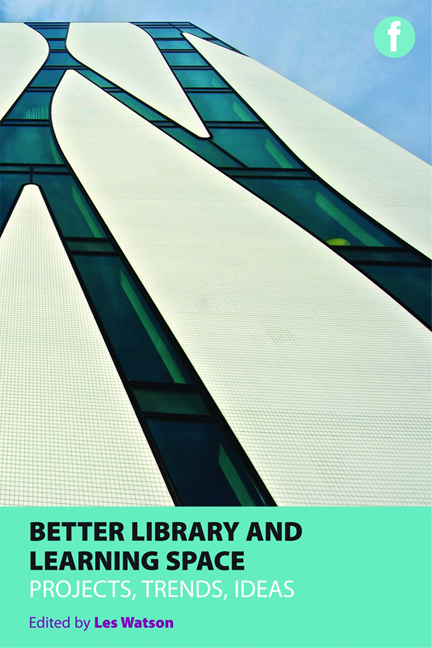Book contents
- Frontmatter
- Contents
- Case studies
- Acknowledgements
- Contributors
- Introduction – about this book
- PART 1 PROJECTS AND TRENDS
- PART 2 TRENDS AND IDEAS
- Introduction
- 7 Library space and technology
- 8 Library space and learning
- 9 Key ideas on space
- 10 Thinking it through
- Summary to Part 2
- PART 3 IDEAS AND FUTURES
- Index
Summary to Part 2
from PART 2 - TRENDS AND IDEAS
Published online by Cambridge University Press: 08 June 2018
- Frontmatter
- Contents
- Case studies
- Acknowledgements
- Contributors
- Introduction – about this book
- PART 1 PROJECTS AND TRENDS
- PART 2 TRENDS AND IDEAS
- Introduction
- 7 Library space and technology
- 8 Library space and learning
- 9 Key ideas on space
- 10 Thinking it through
- Summary to Part 2
- PART 3 IDEAS AND FUTURES
- Index
Summary
This part of the book has looked (in Chapters 7 and 8) at aspects of technology and learning in the context of library space development. Switching the technology system that is the library from a focus on technology for operational management to a more strategic focus on user need and user choice links closely with the ideas in Chapters 8 and 9 on variety and flexibility, in both space and service provision, to support learning. Chapter 8 argues for a new approach to education, shifting from an industrial model to one based on individual capability and performance that acknowledges difference, conversational learning and emotional factors. The 21st-century library has a key role to play in this shift becoming a more important place of learning than ever before by providing variety and giving learners real choices – of space, technologies and services. This variety is not about separate silos but about a continuum of experiences and interactions with resources, technologies and people, understanding not just how people learn but also how space can support them through its variety and flexibility. Finding out what works with space and technology is an essential part of the 21st-century library, requiring continuous experimentation.
This experimentation needs imagination and in Chapter 10 I covered some ways of thinking about library and learning space development that can help develop for the imagination needed to come up with new ideas that work. Exposure to a broad range of ideas is important to feed the imagination and in the final part of this book there are 14 chapters from a range of perspectives to provide some food for thought.
- Type
- Chapter
- Information
- Better Library and Learning SpaceProjects, trends and ideas, pp. 145 - 146Publisher: FacetPrint publication year: 2013

